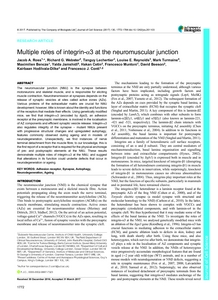Ross, JA;
Webster, RG;
Lechertier, T;
Reynolds, LE;
Turmaine, M;
Bencze, M;
Jamshidi, Y;
Cetin, H;
Muntoni, F;
Beeson, D;
et al.
Ross, JA; Webster, RG; Lechertier, T; Reynolds, LE; Turmaine, M; Bencze, M; Jamshidi, Y; Cetin, H; Muntoni, F; Beeson, D; Hodilvala-Dilke, K; Conti, FJ
(2017)
Multiple roles of integrin-α3 at the neuromuscular junction.
Journal of Cell Science, 130 (10).
pp. 1772-1784.
ISSN 0021-9533
https://doi.org/10.1242/jcs.201103
SGUL Authors: Jamshidi, Yalda
![[img]](https://openaccess.sgul.ac.uk/108884/1.hassmallThumbnailVersion/1772.full.pdf)  Preview |
|
PDF
Published Version
Available under License ["licenses_description_publisher" not defined].
Download (7MB)
| Preview
|
Abstract
The neuromuscular junction (NMJ) is the synapse between motoneurons and skeletal muscle, and is responsible for eliciting muscle contraction. Neurotransmission at synapses depends on the release of synaptic vesicles at sites called active zones (AZs). Various proteins of the extracellular matrix are crucial for NMJ development; however, little is known about the identity and functions of the receptors that mediate their effects. Using genetically modified mice, we find that integrin-α3 (encoded by Itga3), an adhesion receptor at the presynaptic membrane, is involved in the localisation of AZ components and efficient synaptic vesicle release. Integrin-α3 also regulates integrity of the synapse – mutant NMJs present with progressive structural changes and upregulated autophagy, features commonly observed during ageing and in models of neurodegeneration. Unexpectedly, we find instances of nerve terminal detachment from the muscle fibre; to our knowledge, this is the first report of a receptor that is required for the physical anchorage of pre- and postsynaptic elements at the NMJ. These results demonstrate multiple roles of integrin-α3 at the NMJ, and suggest that alterations in its function could underlie defects that occur in neurodegeneration or ageing.
Statistics
Item downloaded times since 31 May 2017.
Actions (login required)
 |
Edit Item |


